Physical Address
304 North Cardinal St.
Dorchester Center, MA 02124
Physical Address
304 North Cardinal St.
Dorchester Center, MA 02124
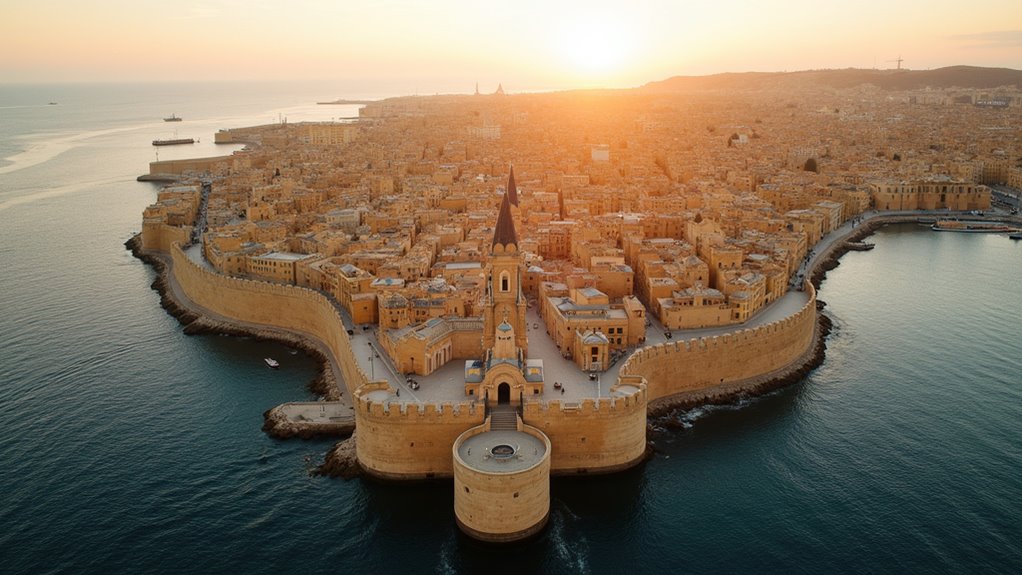
This UNESCO-filled citadel packs 320 monuments into a half-kilometer area, but is Valletta's historic density worth your precious vacation time?
Valletta rewards visitors with Europe’s most concentrated historic area – over 320 monuments in just 0.55 km². You’ll find stunning Baroque architecture, impressive military fortifications, and cultural treasures like St. John’s Co-Cathedral, all within walking distance. The city’s walkability (92/100 Walk Score) makes exploring affordable, while its central location provides easy access to Malta’s highlights. Authentic Maltese cuisine and seasonal festivals add prosperous cultural dimensions to your journey through this UNESCO gem.
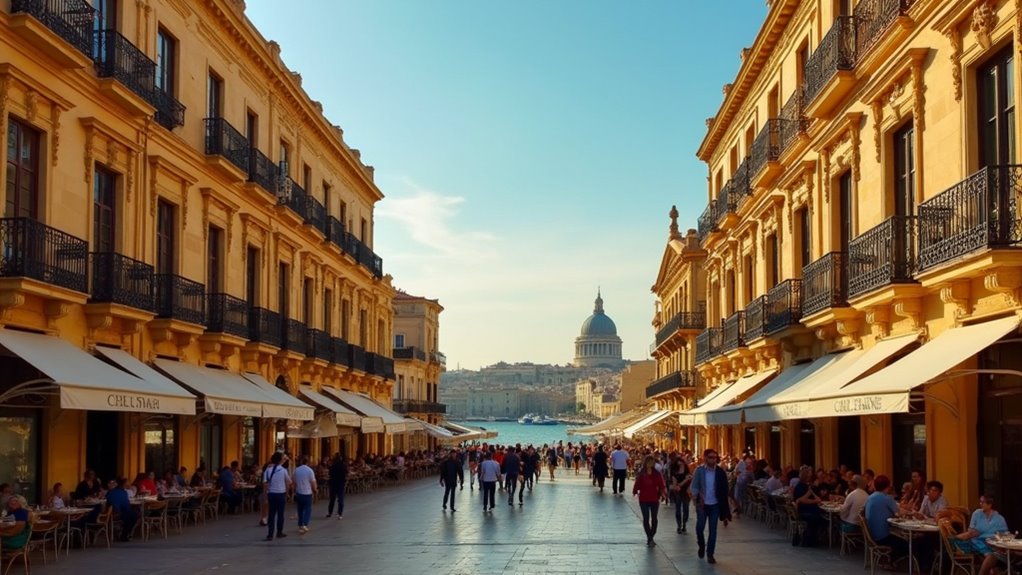
When you wander through the streets of Valletta, you’ll immediately notice the city’s breathtaking Baroque architecture, which dominates the landscape with its grandeur and artistic flair. The Auberge de Castille serves as the most monumental example, rebuilt in 1741 with impressive perspective techniques that create dramatic visual effects. This architectural masterpiece exemplifies the high Baroque style that flourished during Grand Master Pinto’s rule.
You don’t need to pay entrance fees to appreciate structures like the Castellania (1748) or Palazzo Parisio (1750), where ornate details and curved forms exemplify the period’s distinctive style. The strategic use of light and shadow across building facades offers a free visual feast as you explore. After experiencing Valletta’s splendor, many travelers seek similar beauty in underwater landscapes at snorkeling destinations nearby.
Valletta’s Baroque buildings weren’t just beautiful—they were statements of power designed to rival European capitals. This cultural heritage makes the city an open-air museum of architectural innovation worth experiencing firsthand.
Beyond the stunning Baroque façade of Valletta lies a capital city forged in the fires of conquest and survival. When you stroll these streets, you’re walking through living history that began after the Knights of St. John repelled Ottoman forces in the Great Siege of 1565.
Founded in 1566 by Grand Master Jean Parisot de Valette (the city’s namesake), Valletta was purpose-built as a fortress capital with a precise grid layout. The Knights’ legacy surrounds you in the auberges, St. John’s Cathedral, and the Grand Master’s Palace. The city became Malta’s official capital in 1571, when Grand Master Pierre de Monte relocated there from the former capital. Unlike Scandinavian capitals that spread across larger landmasses, Valletta’s compact design maximizes defensive advantages while showcasing architectural brilliance.
UNESCO recognized this remarkable heritage in 1980, citing over 320 monuments packed into this compact city. Despite WWII bombing that destroyed landmarks like the Royal Opera House, Valletta remains Europe’s most concentrated historic area—a testament to Malta’s resilience.
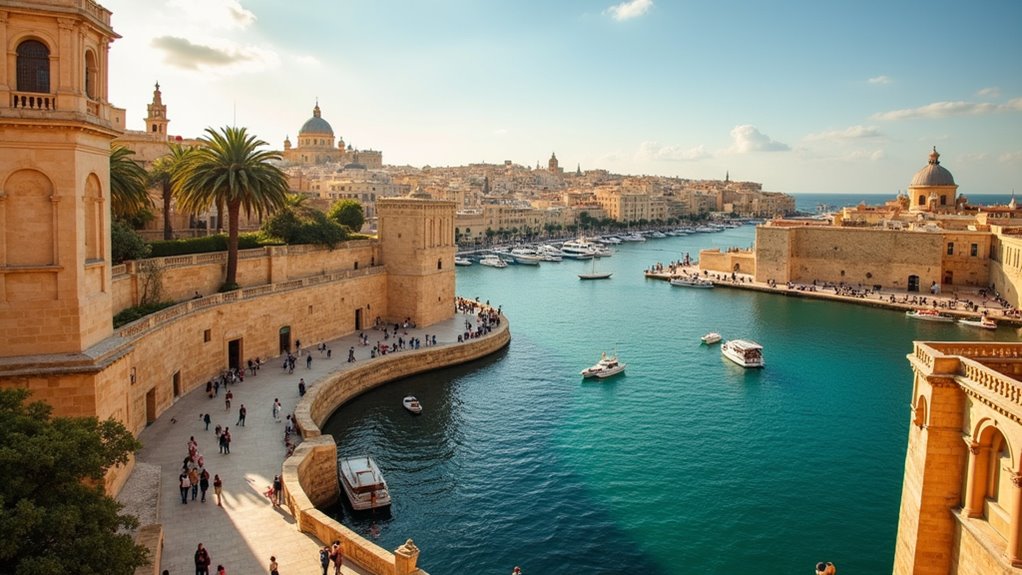
While Valletta’s history enthralls visitors, its breathtaking harbor views and lush gardens might be the city’s most enchanting features. From the Upper Barrakka Gardens, you’ll enjoy panoramic vistas of the Grand Harbour, especially magical at sunset when golden light bathes the landscape.
Don’t miss the Lower Barrakka Gardens with its notable Siege Bell War Memorial and equally impressive views. Both gardens are free to enter, making them perfect budget-friendly respites from sightseeing.
For a different perspective, stroll along Valletta Waterfront at Pinto Wharf, where restaurants and shops occupy historic buildings. The scenic waterfront has an impressive 4.4/5 bubbles rating from visitors who praise its bustling atmosphere and picturesque setting. If you can spare a few euros, the Sliema Harbor Cruise offers excellent value, passing Fort Manoel and providing unique photography opportunities of the impressive fortifications that have guarded this crystal-clear Mediterranean harbor for centuries. Many visitors find Valletta’s coastal charm reminiscent of Croatian beaches, though with a distinct Maltese character all its own.
Valletta’s imposing fortifications stand as proof of Malta’s remarkable military heritage, perhaps one of Europe’s most impressive defensive systems ever constructed. Born from the lessons of the 1565 Great Siege, the city’s grid layout incorporates ingenious angular bastions designed for deadly crossfire against invaders.
Don’t miss Fort St. Elmo, whose fall during the Ottoman siege prompted the building of Valletta itself. The massive Floriana Lines and Cottonera Lines represent extraordinary engineering feats, with dry moats reaching depths of 20 meters.
Fort Manoel’s perfect baroque square design guards the western harbor approach. The city’s primary land fortifications, including the extensive bastions and cavaliers, were largely completed in the 1560s-70s and remain remarkably intact today.
What makes these fortifications special is their continual evolution—from the Knights’ original bastions to British modifications for ironclad warfare, all crafted from local limestone yet engineered to withstand centuries of military advancement. Unlike Croatian destinations, Valletta offers a uniquely concentrated defensive system within a compact UNESCO-protected peninsula.
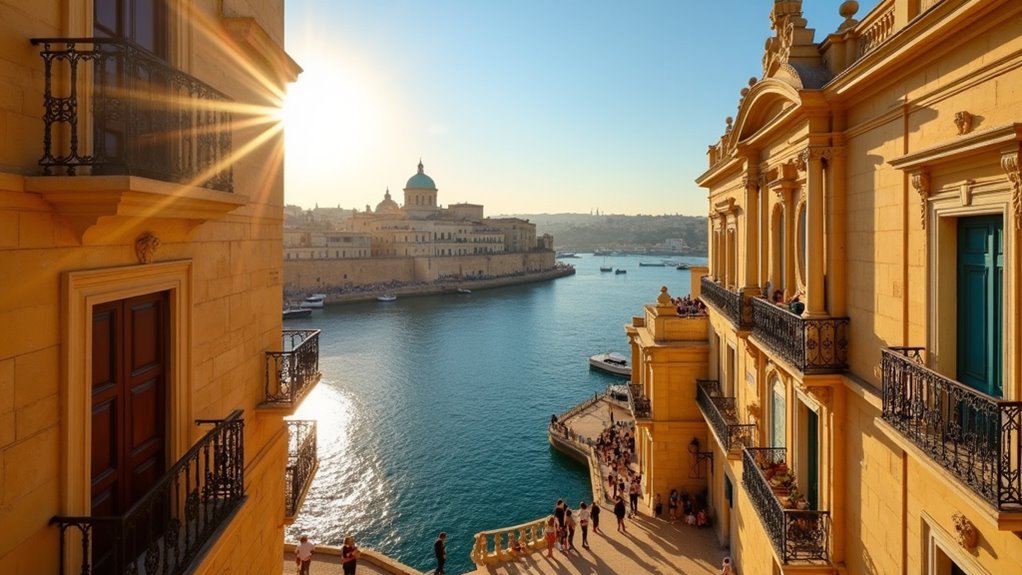
The same limestone walls that protected Malta through centuries of conflict now shelter some of Europe’s most impressive cultural collections. MUŻA, housed in the 16th-century Auberge d’Italie, offers a journey through Maltese art history.
The National Museum of Archaeology displays treasures like the 5,000-year-old “Sleeping Lady” figurine.
Don’t miss Casa Rocca Piccola, where you’ll glimpse aristocratic life in a genuine 16th-century palace.
For niche interests, explore the Toy Museum’s vintage collections or descend into Underground Valletta to discover ancient water systems. St. John’s Co-Cathedral dazzles visitors with its Baroque architecture and detailed interior.
Like Split’s Diocletian’s Palace, Valletta offers a rare chance to experience living history within its ancient fortress walls.
The Grand Master’s Palace State Rooms showcase lavish interiors with Flemish tapestries.
While Europe’s third-oldest working theater, Teatru Manoel, offers both performances and historical tours at reasonable prices.
Most museums are within walking distance, making Valletta a budget-friendly cultural destination.
Savoring authentic Maltese cuisine counts among Valletta’s most rewarding experiences, offering travelers an affordable glimpse into the island’s cultural heritage. The city’s eateries showcase Mediterranean staples like bigilla (tic bean dip) and kapunata (Maltese ratatouille), which reflect centuries of regional influence.
You’ll find traditional cooking methods still practiced, with community ovens producing fresh bread stuffed with tuna, capers, and olives. The irresistible ftira biz-zejt combines tuna and pickled vegetables on traditional Maltese sourdough bread, creating a satisfying local sandwich experience. Don’t miss soppa tal-armla (widow’s soup) or qarabaghli mimli (stuffed marrow) for an authentic taste of local ingenuity.
Valletta’s dining scene ranges from casual market stalls to atmospheric restaurants, all highlighting fresh local ingredients—seafood, vegetables, and fruits. The city’s historical backdrop transforms every meal into a culture where Catholic, Italian, and British influences merge on your plate. Unlike global city rivals, Valletta preserves culinary traditions that remain relatively unchanged by international tourism trends.
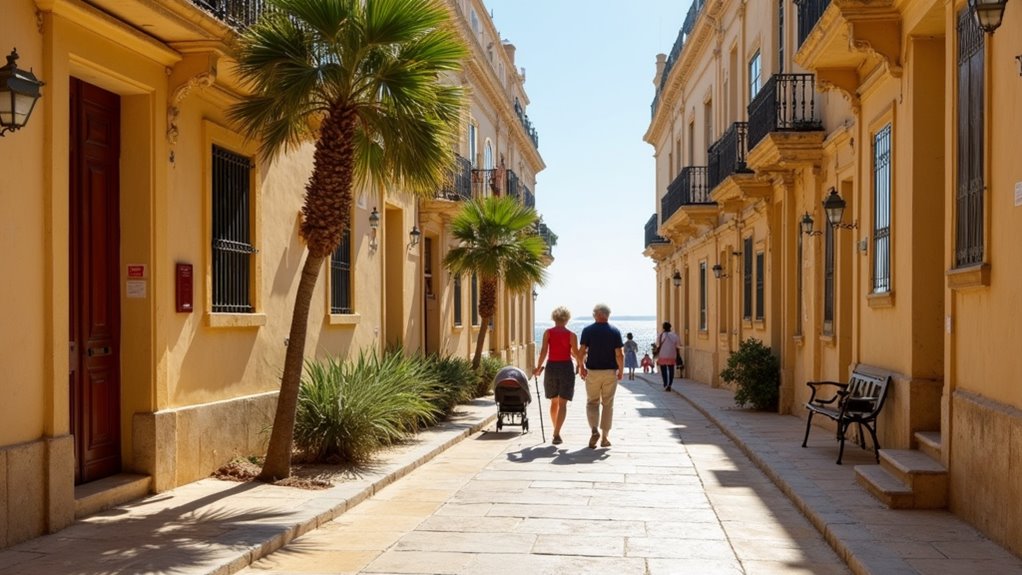
Designed as a compact fortress capital, Valletta offers you an exceptionally walkable urban experience with a remarkable Walk Score of 92/100. The city’s entire 0.55 km² area can be traversed on foot, with its grid-pattern streets originally designed for armored soldiers now serving modern pedestrians perfectly.
You’ll appreciate these key accessibility benefits:
The steeper inclines present challenges for some visitors, but the compact design makes Valletta uniquely navigable. Like Mediterranean island Cyprus, Valletta offers visitors an immersive way to experience local culture through its pedestrian-friendly streets. This architectural planning created what is now classified as a Walkers Paradise where no car is needed for most daily activities.
While Valletta’s walkability makes it a joy to explore on foot, its strategic position at the heart of Malta transforms it into an ideal launching pad for discovering the entire island nation. The city’s central transportation hub connects you to every corner of Malta via affordable public buses.
Valletta’s central location offers Malta in miniature—walking-friendly streets at home, the entire island accessible by transit.
From Valletta, you’re just a short journey from the medieval silence of Mdina, the colorful fishing boats of Marsaxlokk, or the historic Three Cities accessible by inexpensive ferry. After exploring these areas, visitors can return to view the spectacular Saluting Battery which fires cannons daily at noon from the Upper Barrakka Gardens. Similar to how visitors choose between Cypriot resorts when planning a Mediterranean getaway, Malta offers diverse experiences within close proximity.
Day trips to Gozo and Comino’s azure waters are easily arranged, letting you experience Malta’s diverse landscapes without changing accommodations.
After days exploring ancient temples, swimming in crystal waters, or wandering through Roman ruins, you’ll return to Valletta’s wealth of dining options and cultural events—practical benefits that stretch your travel budget while maximizing authentic experiences.
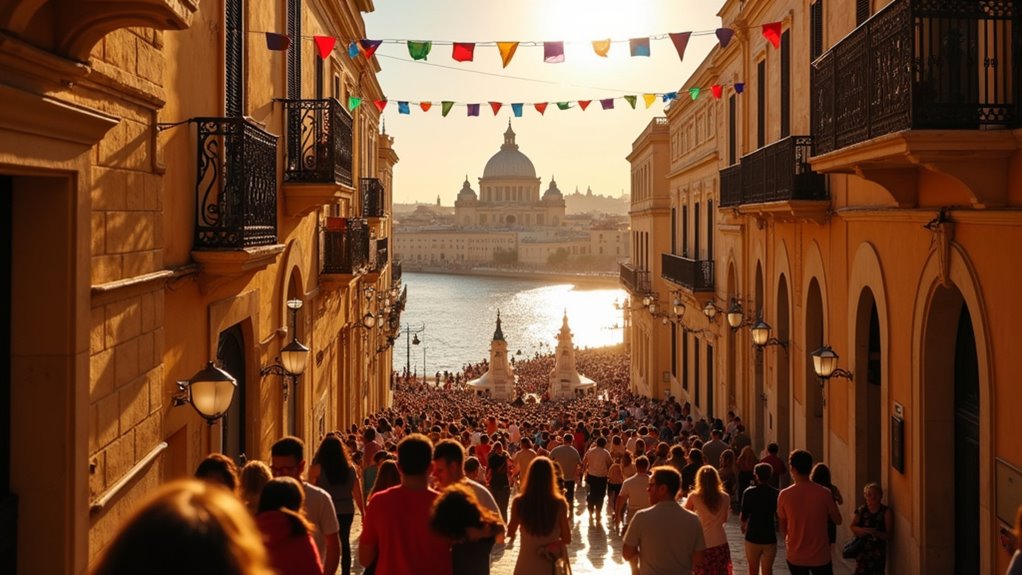
Beyond its architectural splendors, Valletta transforms throughout the year with festivals and celebrations that showcase Malta’s vibrant cultural heritage without straining your travel budget.
Time your visit to experience these extraordinary events:
You’re convinced you’ve found an “undiscovered gem” in Valletta—just like those other 2 million travelers annually. Your Instagram will absolutely benefit from baroque architecture shots nobody’s ever taken before. Sure, you’ll drain your savings on harbor-view cocktails, but hey, you’ll get cultured! Malta’s capital delivers bang for your buck if you don’t mind sharing your “authentic experience” with cruise ships disgorging passengers by the thousands.